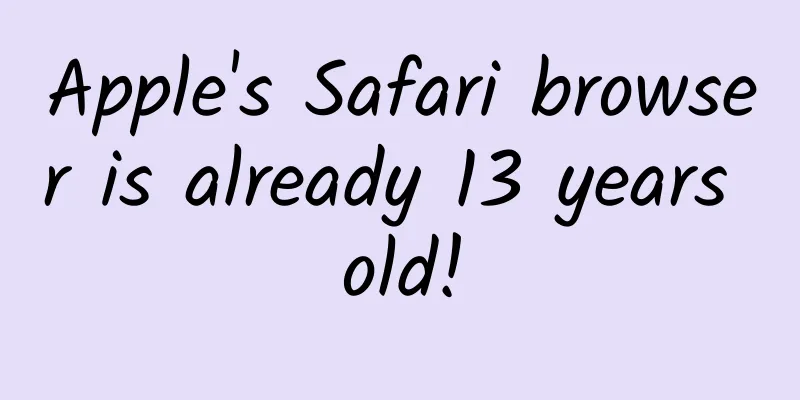Apple's Safari browser is already 13 years old!

|
In 2003, Apple released Safari, the "fastest web browser ever built", for the Mac. Four years later, it brought a new mobile browser experience to the iPhone. The emergence of Safari seemed to lag behind the development of HTML. The years of war between Microsoft and Netscape/Mozilla gave rise to corresponding browser engines and imposed certain restrictions on the emergence of new competitors.
Jobs said: "We've built the first all-new browser in many years, bringing innovation back to the field." Return to open web standardsLaunching its own browser has won Apple important influence with users, increased the interest of other browser manufacturers in providing support for the Mac platform, and given Apple greater control over the direction of Web standards. Apple not only launched its own browser application, but also developed a unique WebCore browser engine (based on a branch of the existing KHTML open source project) to compete with Microsoft's Trident and Mozilla's Gecko. The company is committed to opening up complete web standards, rather than the proprietary web extensions favored by Microsoft, to allow developers to be more consistent and fair. In 2008, WebKit became the first browser engine to fully pass the Acid3 rendering test. Owning this key technology allowed Apple to adopt HTML5 as an open option ahead of the curve (web apps and videos require proprietary middleware such as Adobe Flash or Microsoft Silverlight). One of the core features of HTML5 is Canvas. Apple contributed this patented technology for free to accelerate the development of the open network, which obviously also cost Microsoft and Adobe a certain price.
Safari on iPhone (2007). A large open source projectSafari's WebCore and JavaScript core libraries (both derived from KHTML) have always been open source. In 2005, Apple announced that it would open the entire browser implementation to the community. The resulting WebKit allowed other manufacturers to quickly launch their browsers. Nokia made an effort and brought WebKit to its mobile platform, while Google launched the Chrome browser for Windows platform, taking precedence over Mozilla's IE replacement. Apple initially maintained a port of Safari for Windows PCs, but eventually discontinued the project as Google and other developers took over the maintenance of WebKit on the Windows platform. In 2007, Apple launched the Safari browser for the first generation iPhone, which used the same WebKit engine and supported multi-touch interaction. Jobs said: "We wanted to have the best web browser on a phone, so we picked the best browser in the world, Safari. We put it on the iPhone - it's the first fully usable browser on a phone." Since Apple subsequently brought WebKit to the Android platform, the browser engine led by Apple soon had an overwhelming competitive advantage over the PC desktop platform and dominated the mobile browser market. |
<<: New Wi-Fi technology is available that's better suited for smart homes
>>: 11 Predictions for Web Design Trends in 2016
Recommend
App Store 5th Anniversary: A Review of the Best Apps of the Year
In July 2008, Apple officially launched the App S...
1 operation philosophy, 8 core words to understand operation
For friends who are just starting out in the oper...
Identify the three levels of channel fraud from operational data!
How to judge the quality and cunningness of the c...
How to promote your products effectively?
In most cases, many people are easily influenced ...
People's Daily comments on Bitcoin: The so-called advantages are all a cover for speculation
In the past 2017, the soaring and plummeting of B...
If you use the wrong posture, you can get sick! 4 toilet movements that many people do every day
Mr. Liu, 43, has suffered from hypertension for m...
9 factors that content marketing veterans won’t ignore when planning
Effective marketing increasingly relies on storyt...
What changes have taken place in social software? Where will it go next?
Boss, I want to buy this mobile phone. Is QQ inst...
The most complete! Practical guide to operating Douyin corporate accounts!
Douyin is undoubtedly an important battlefield fo...
Are you hungry? Don’t worry, there is something to tell you about fasting before the physical examination!
Physical examination is an important part of main...
What is the magic of big data from the Internet to the Internet of Vehicles?
The movie that has been popular in the circle of ...
World Sleep Day | Can’t sleep during the afternoon? Here’s everything you want to know about naps!
Today is World Sleep Day. Many people are concern...
From the "reputation-building missile" to Huawei's "reputation-building aircraft", what other "technological breakthroughs" are there on the road to becoming a strong country that you don't know about?
Planning: Little Dandelion, 91 Copywriter: Xiaoxi...
How much does it cost to customize a nutritional product mini program in Nujiang?
How much does it cost to customize a nutritional ...
New energy vehicle rural promotion campaign launched, ten companies offer discounts to third-tier and fourth-tier cities and below, with the highest discount of 8,000 yuan
On July 15, 2020, the Ministry of Industry and In...









